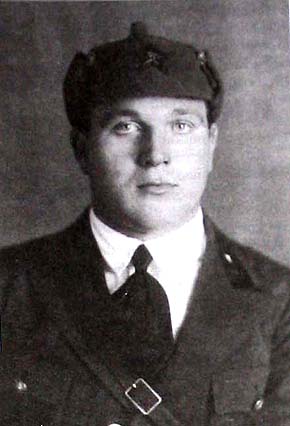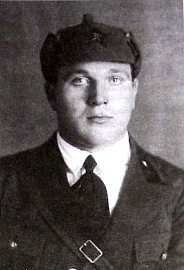 M.S.: Aleksej Andreevich, how did you come to choose a military career?
M.S.: Aleksej Andreevich, how did you come to choose a military career?
As I was born in a peasant family, I originally had no intention of devoting my life to military service. When I was drafted, I used my time in the army to finish the regimental school. However, just as I was coming up on my discharge, my friends and I were informed that the Defense Minister ordered that our service be extended, and that we are to transfer to an artillery training school.
It was 1938. We couldn’t refuse this order. I still have vivid memories of one episode from those days, when during the morning roll call the officers command everyone to stand at attention, then suddenly one of them shouts at someone in the back ranks: “Belay that! You – you are an Enemy of the People!” [Official term for many of those arrested during Stalin’s purges – Transl.] “Me, an Enemy of the People? But how?” – the soldier protests. But no-one listens to him, and he is taken away right then and there.
I remember a lot of arrests like this. That’s how it was in those days. Regardless, I still wanted very much to go home, to my village in the Penza region. So I decided to ask my commander to transfer me to a tank school instead of the artillery course, justifying the request by the fact that before I was drafted, I had graduated from an automotive mechanical institute. I had hoped that switching to tanks would eventually free me from the service – how I was mistaken! At any rate, my commander agreed to my request and that’s how I wound up in the tank school at Rjazan’.
M.S.: How did the Polish War of 1939 begin for you?
The same as for everyone else – on the early morning of September 17, 1939, the Red Army crossed the Soviet-Polish border. By that time, I had graduated from the Rjazan’ tank school and was commissioned as an officer. We managed to break the Poles’ initial resistance and begin our advance beyond the border, but we ran into very heavy action in Belovezhskaja Pushha. We did have losses there. However, eventually we overcame that resistance as well, and drove to Brest-Litovsk. After Belorussia, our forces advanced into Western Ukraine, where my regiment had to spend two weeks assaulting the city of L’vov.
On our way back home, when we were passing through the Mogiljov region, I met my future wife, a young kindergarten teacher named Natasha. It would still be a while before we got married though. The regiment spent only two weeks in Mogiljov when one night an alarm summoned all the officers to headquarters. There, the regiment’s commander informed us that we were ordered to load our equipment on trains and ride north, where we would be added to the forces of the Leningrad Military District. There were immediate questions, of course – why, how. Our commander answered that he knew as much as we did, and this uncertainty made me feel a bit uncomfortable. My regimental comrades felt the same way.
What was going on? Well, towards the end of November we were told that the Finns had shelled Soviet territory. That’s when the Red Army went into combat in Finland. From the first days of that operation I realized that this war would not be nearly as easy as was envisioned by command, which had expected a relatively costless victory within two to three weeks. Advancing through heavily forested terrain full of Finnish snipers was very difficult. The Finns fought bravely, and were very well armed. And the weather seemed to be on their side – that winter was unusually harsh, and the snow reached three meters deep in places. Our officers were issued warm white fur coats, while the soldiers received thick leather jackets. Finnish snipers, of course, targeted primarily officers, their leaflets even said: “Kill the white-furs!” All that was just a prelude to the real fighting, however. When we reached the Mannerheim Line, we were forced to a standstill by the heavy Finnish fire. Worst of all, one could not even tell where that fire was coming from.
The thick forest masked the Finnish emplacements. Something had to be done – headquarters ordered suppressive fire over open sights from all available weapons. We complied with the order, of course. The shells literally obliterated the woods, and then we saw the Finnish defenses. These were egg-shaped, and constructed in a checkerboard pattern. Just imagine – concrete, two-storied structures. We later determined that each floor had eighteen heavy machine-guns, and there was also an artillery position at the top of each emplacement. After the war I found out that the Finns had been constructing these positions for twenty seven years across the entire Karelian Isthmus. And back then, we couldn’t even approach them. The tanks would bury themselves in deep snow, or else be stymied by concrete-lined ditches or all the trees cut down by our shellfire.
Headquarters than ordered us to bring up heavy railroad-bound howitzers (monster 500 millimeter caliber guns, where each shell weighted 400 kilograms!). You’d look at one of these things and think – this brute can smash through any defense. Of course, by that time, we had learned not to be too optimistic. I remember that part quite well.
Besides the howitzers, the Finnish defenses were attacked by our aircraft dropping bombs that weighed several hundred kilograms each. There was a constant din of explosions, though we, as tankers, were already more or less used to it. But I was really unnerved when I saw that all these shells and bombs left hardly a mark on the enemy fortifications. We understood then that the battle won’t be that simple for us.
M.S.: Were there strains of panic?
No, not at that point. We were being told that command was working on new offensive plans, but in the meantime we had to hold our positions. Of course, the wait was both hard and dangerous. The Finns kept on an incessant fire, and temperatures fell to minus 50 degrees Centigrade (roughly minus 45 degrees Farenheit – Transl.). No fur coat could protect you from that. That was the coldest I’ve ever been in my entire life.
Meanwhile, command decided to mount a new attack using so-called “infantry tanks” specially manufactured for this purpose. You know what they called an “infantry tank”? Each “tank” was a plate of 12 millimeter armor with a firing slit for the rifle (the Red Army did not have SMGs then), which doubled as the vision slit for the soldier behind the plate. The entire contraption was mounted on skis and weighed over 80 kilograms.
Now, think about this – the designers really believed that we could use these things to encircle and break through the Mannerheim Line. Of course, reality had other ideas. The skis would cross or tilt, and the “infantry tanks” sank into two meters of snow. Many of my friends died then. I especially remember how one soldier, heavily wounded but still alive, tried to cover his face to ease his pain – but froze before he could bring his hands up. Our losses were enormous, with virtually no results. That’s when our morale really fell, and people began to whisper dissent. That’s when command ordered another round of artillery and aerial bombardment, with bombs and shells harmlessly ricocheting off the Finnish emplacements once again. On the fourth day, the infantry was ordered forward, and the Finnish lines were captured with no enemy resistance whatsoever.
As someone had explained to me, the incessant shelling began to starve the fortifications of air. And so the Finns left using secret underground passages one and a half to two kilometers long. Of course, no-one knew that the Finns had left until after their emplacements were captured. After that, there was still heavy fighting, the so called “Valley of Death”, where many of my comrades perished. By some miracle, I managed to survive. At noon on March 12, 1940, the Russo-Finnish War came to an end. I still remember the exact time. In January of 1941 I got married, and when on June 22 the Great Patriotic War began, my wife was already pregnant. I first saw the child only when I came home after the war. I went through my third war from beginning to end as with my first two, was captured, twice escaped imprisonment, went through a “loyalty verification” process in a KGB prison camp, and then, having returned to the front, celebrated Victory Day on a hospital bed.
| Interviewer: | Maksim Sviridenkov |
| Editing: | Maksim Sviridenkov |
| Translation: | Gene Ostrovsky, taladryel@yahoo.com |


